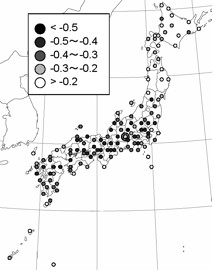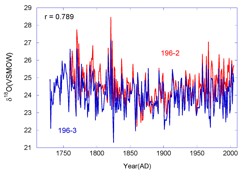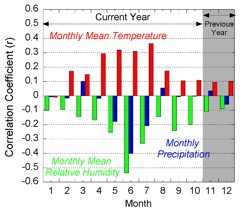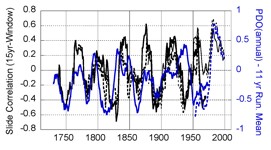|
PAGES Japan
national science highlight
Non-stationary and cyclic teleconnection between Japanese summer monsoon (Baiu) and ENSO during last three centuries: Evidence from δ18O of tree-ring cellulose in Japanese cypress
Takeshi NAKATSUKA, Keiko OHNISHI (Institute of Low Temperature Science, Hokkaido University) & Takumi MITSUTANI (Nara National Research Institute for Cultural Properties)
 |

Figure 2. Variations in δ18O of tree-ring cellulose in two Japanese cypresses.
|
Figure 1. Location of sample site ◎ and distributions of meteorological observatories in Japan 〇, whose gray scales indicate the correlation coefficients (r) between variations of June monthly mean relative humidity there and the tree-ring δ18O in this study from 1951 to 2005. |
 |
 |
Figure 3. Correlation coefficients between the averaged tree-ring δ18O of two cypress and monthly meteorological parameters at Iida from 1898 to 2005. |
Figure 4. 15 years windows of slide correlation between the tree-ring δ18O of two cypress (Solid & Dashed) and ENSO indices (Reconstructed SOI (±reversed to NINO-3): Thick & Observed NINO 3: Thin) (Black); 11 years running mean PDO index (Reconstructed: Solid & Observed: Dashed) (Blue) |
Abstract
Baiu/Meiyu front is one of the most predominant features of East Asian Summer Monsoon and it has been providing Chinese, Korean and Japanese people with many benefits and disasters. Climatological analyses have revealed that Baiu is tightly related to ENSO index in the previous winter, but it is also noticed that the teleconnection is variable in multi-decadal scales. In order to improve predictability of Baiu, it must be very useful to clarify the historical change in Baiu-ENSO teleconnection during pre-instrumental periods. Although tree ring is one of the most reliable proxies to reconstruct past climate, tree ring widths have never been used for clarification of Baiu, because in Japan, precipitation is too much to limit the tree growth and tree-ring widths are often affected by ecological competition with neighboring trees. Here, we introduce the δ18O of tree-ring cellulose, which can directly indicate past summer hydroclimate, for the first time in central Japan.
In 2005, two tree-ring disks (245 and 276 yrs old) were collected from Japanese cypress at southern part of Nagano prefecture (Fig. 1). Historical variations of δ18O in α-cellulose extracted from two disks are very similar to each other (Fig. 2) and regression analyses between the averaged δ18O and monthly meteorological parameters at the closest observatory show that the tree-ring δ18O has the highest (negative) correlation with monthly mean relative humidity and precipitation in June (Fig. 3). Correlations with June hydroclimate were found not only at the near observatories, but also at very wide area extending zonally along central Japan (Fig. 1), indicating that the tree-ring δ18O can be a proxy of Baiu front activity there, which intensifies every June.
In order to investigate the possible long-term changes in Baiu-ENSO teleconnection, we conducted slide correlation analyses between variations in ENSO indices (reconstructed Southern Oscillation Index (Stahle et al., 1998, Bull. American Meteorological Society 79: 2137-2152) and recently observed NINO-3 SST) and the individual tree-ring δ18O of this study (Fig. 4). During last 270 years, the correlation between Baiu (δ18O) and ENSO has been reversed cyclically at about 40 years intervals. The latest reversal corresponds to the regime shift occurred in 1970's, indicating that the instrumentally observed non-stationariness is part of a longer-term climatic phenomenon. Interestingly, the cyclic change in Baiu-ENSO correlation is coincident with the long-term change in observed and reconstructed Pacific Decadal Oscillation (D'Arrigo et al., 2001, Climate Dynamics, 18, 219-224) (Fig.4), suggesting that the predictability of Baiu can be improved by considering other indices of atmospheric circulation together with ENSO.
|

